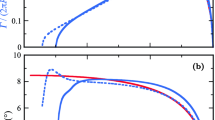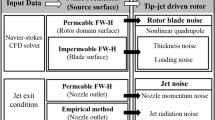Abstract
Tip-jet rotors operate in an equilibrium state between aerodynamic torque generated by rotations and jet torque by a tip-jet. This equilibrium state is denoted by the torque-balanced state and a corresponding tip speed is called as the equilibrium tip speed. As a noteworthy result, consistent jet-wake interactions (JWIs) cause similar flow structures that is independent of tip-jet flow condition at a specified collective pitch angle. Accordingly, the constant induced flow ratio leads to the constant net thrust coefficient nondimensionalized with the equilibrium tip speed. Furthermore, at the torque balanced state, trajectories of the tip-jet vortices remain unchanged irrespective of blade tip speeds. The net thrust coefficient in real situation primarily depends on the collective pitch angles and the momentum theory for conventional rotor analysis can be applied to the tip-jet rotor in the torque-balanced state.











Similar content being viewed by others
References
Johnson W (2011) Milestones in rotorcraft aeromechanics, NASA/TP-2011-215971
Kim JM (2015) KARI experience of the compound rotorcraft concept study and recent trend of high-speed VTOL Development in the world. In: Proceedings of Korean Society for Aeronautical & Space Sciences Fall Conference, pp 866–870
Philips J (1991) An efficient tip jet drive. Aircraft Design and Operations Meeting of AIAA, 3124
Hislop GS (1958) The Fairey Rotodyne. Fairey Aviation Company
Harris FD (2003) An overview of autogyros and the McDonnell XV-1 convertiplane, NASA/CR-2003-212799
Mitchell C, Vogel B (2003) The cannard rotor wing (CRW) aircraft—a new way to fly. In: AIAA International Air and Space Symposium and Exposition: the next 100 years
Schwartz AW (1993) Tipjet 80-inch model rotor hover test: Test No. 1198. Research and envelopment Report, Carderock Division, Naval Surface Warfare Center, Bethesda, Maryland, USA
Jung YW, Jun YM, Yang SS (2003) The application of CFD for the duct system design of CRW aircraft. In: Proceedings of Korean Society for Computational Fluids Engineering Spring Conference, pp 200–205
Moodie AM (2008) A new methodology for sizing and performance predictions of a rotary wing ejector. Dissertation, Georgia Institute of Technology, Atlanta, USA, pp 83–130
Park D, Park SH (2018) A parametric study on the tip-jet rotor performance with the duct inlet pressure and the blade tip speed. J Comput Fluids Eng 23(3):94–103
Leishman JG (2002) Principles of helicopter aerodynamics. Cambridge University Press, pp 33–36
Park D, Park SH (2020) A study on prediction methodology to determine the equilibrium tip speed of tip-jet rotor. J Comput Fluids Eng 25(2):66–75
Kim JW, Park SH, Ko JH, Park I, Jung SN, Yu YH, Kim E, Kwon JH (2008) Hovering rotor computation including aero-elastic effects with an overlapped grid Navier-Stokes solver. In: Proceedings of 26th AIAA Applied Aerodynamics Conference, pp 6729–6741
Roe PL (1981) Approximate Riemann solvers, parameter vectors, and difference schemes. J Comput Phys 2(43):357–372
Park SH, Kwon JH (2004) Implementation of k-w turbulence models in an implicit multigrid method. AIAA J 42(7):1348–1357
Menter FR (1994) Two-equation Eddy-viscosity turbulence models for engineering applications. AIAA J 32(7):1598–1605
Caradonna FX, Tung C (1981) Experimental and analytical studies of a model helicopter rotor in hover. In: European rotorcraft powered lift aircraft forum, No A-8332
Acknowledgements
This work was supported by the National Research Foundation of Korea (NRF) grant funded by the Korea Government (MSIT) (2021R1A5A1031868).
Author information
Authors and Affiliations
Corresponding author
Ethics declarations
Conflict of interest
On behalf of all authors, the corresponding author states that there is no conflict of interest.
Additional information
Publisher's Note
Springer Nature remains neutral with regard to jurisdictional claims in published maps and institutional affiliations.
Rights and permissions
Springer Nature or its licensor (e.g. a society or other partner) holds exclusive rights to this article under a publishing agreement with the author(s) or other rightsholder(s); author self-archiving of the accepted manuscript version of this article is solely governed by the terms of such publishing agreement and applicable law.
About this article
Cite this article
Park, D., Park, S.H. Effect of Jet–Wake Interaction around a Tip-Jet Rotor in Torque-Balanced States. Int. J. Aeronaut. Space Sci. (2024). https://doi.org/10.1007/s42405-024-00724-6
Received:
Revised:
Accepted:
Published:
DOI: https://doi.org/10.1007/s42405-024-00724-6




